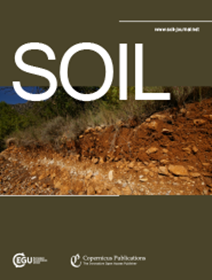Limited effect of organic matter addition on stabilised organic carbon in four tropical arable soils
IF 4.3
2区 农林科学
Q1 SOIL SCIENCE
引用次数: 0
Abstract
Abstract. Arable soils are generally characterised by a low soil organic carbon (SOC) content, with negative consequences for soil health, crop yield and global climate. Thus, over the past decades, there has been a focus on how agricultural management practices, such as organic resource addition, can increase the amount of SOC. To sustainably increase SOC stocks, a portion of the organic amendments added to the soil has to be stabilised in persistent fractions such as mineral-associated organic carbon (MAOC). However, there is a lack of research on the magnitude of changes in MAOC in tropical agroecosystems in response to organic resource additions. Here, we show for four long-term field trials in Kenya that the addition of large amounts of organic amendments (farmyard manure or Tithonia diversifolia biomass at 4 t C ha-1 yr-1 for 16 to 19 years) to maize monocropping systems had variable effects on topsoil MAOC stocks (0–15 cm depth), and no significant effect on subsoil MAOC stocks (15–50 cm depth) compared to a control treatment. The addition of mineral N fertiliser did not affect MAOC stocks at any site. Using stable carbon isotopes δ13C, we found that the portion of topsoil MAOC originating from Tithonia biomass was larger in the sandy (25–40 %) compared to the clayey soils (0.5–12 %), while the portion of total added Tithonia biomass that was stabilised over a time period of 16–19 years was below 7 % across all sites, or a SOC stabilisation rate of 0.8–27 g C m-2 yr-1. Using these results, we conclude that while in sandy soils the stabilisation of added OC contributed substantially to limiting SOC losses upon cultivation, this was not the case for clayey soils. These differences were due to the much lower SOC stocks in the sandy soils, compared to the clayey soils. Our results underline the challenges associated with improving soil health in sub-Saharan Africa and stress the need for more research to reliably assess if and how additional SOC can be stabilised over decadal time scales in highly weathered tropical soils.添加有机质对4种热带耕地土壤稳定有机碳的有限影响
摘要。耕地土壤通常具有土壤有机碳(SOC)含量低的特点,这对土壤健康、作物产量和全球气候都有负面影响。因此,在过去的几十年里,人们一直关注农业管理实践,如有机资源添加,如何增加有机碳的数量。为了可持续地增加有机碳储量,添加到土壤中的一部分有机改进剂必须稳定在持久性组分中,如矿物相关有机碳(MAOC)。然而,缺乏对热带农业生态系统中MAOC随有机资源添加而变化幅度的研究。在这里,我们在肯尼亚进行了四个长期的田间试验,结果表明,与对照处理相比,在玉米单作系统中添加大量的有机改良剂(农家肥或Tithonia多样性生物量,每公顷4吨,每年1年,持续16至19年)对表层土壤MAOC储量(0-15厘米深度)有不同的影响,对底土MAOC储量(15-50厘米深度)没有显著影响。在任何地点,添加无机氮肥对MAOC存量均无影响。利用稳定碳同位素δ13C分析,我们发现,与粘土土壤(0.5 ~ 12%)相比,沙质土壤中来自铁藻生物量的表层土壤有机碳含量(25 ~ 40%)较大,而在16 ~ 19年的时间内稳定的总添加铁藻生物量的比例在所有样地均低于7%,即SOC稳定率为0.8 ~ 27 g C m-2年-1。利用这些结果,我们得出结论,虽然在沙质土壤中,添加的有机碳的稳定性对限制耕作时的有机碳损失有很大贡献,但在粘性土壤中并非如此。这些差异是由于砂质土壤的有机碳储量远低于粘质土壤。我们的研究结果强调了与改善撒哈拉以南非洲土壤健康相关的挑战,并强调需要更多的研究来可靠地评估在高度风化的热带土壤中是否以及如何在十年时间尺度上稳定额外的有机碳。
本文章由计算机程序翻译,如有差异,请以英文原文为准。
求助全文
约1分钟内获得全文
求助全文
来源期刊

Soil
Agricultural and Biological Sciences-Soil Science
CiteScore
10.80
自引率
2.90%
发文量
44
审稿时长
30 weeks
期刊介绍:
SOIL is an international scientific journal dedicated to the publication and discussion of high-quality research in the field of soil system sciences.
SOIL is at the interface between the atmosphere, lithosphere, hydrosphere, and biosphere. SOIL publishes scientific research that contributes to understanding the soil system and its interaction with humans and the entire Earth system. The scope of the journal includes all topics that fall within the study of soil science as a discipline, with an emphasis on studies that integrate soil science with other sciences (hydrology, agronomy, socio-economics, health sciences, atmospheric sciences, etc.).
 求助内容:
求助内容: 应助结果提醒方式:
应助结果提醒方式:


